Feature Story
Health Center Today, June 10, 2011
Bird Lays Eggs in Middle of Dowling South Parking Lot
By Carolyn Pennington
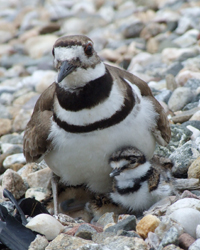
Killdeer with her baby.
Photos by Tina Encarnacion
Update - June 13, 2011: The chicks are here! All four babies look happy and healthy. Even though cones have been set up to protect the area, beware of the babies scurrying around and please be extra careful when driving in the Dowling South parking lot.
It seems like an unlikely spot to give birth – even for a bird – but a mamma killdeer has decided to lay her eggs in the middle of the Dowling South parking lot.
The killdeer’s four speckled eggs blend perfectly with the stones in the gravel section of the lot. Unlike many birds, killdeer don’t build a typical nest for their eggs. There is just a slight depression in the gravel that holds the eggs with a few stones lining the edge. Construction crews have placed cones and netting around the area to protect the precious eggs from being accidentally stepped on.
Cheryl Steciak, an administrative program assistant who works in Dowling South, has been watching the bird for the past few weeks. “The ‘husband’ flies at anyone who tries to disturb her. It really is pretty amazing to think of this Mother Nature driven event in the parking lot here.”
While it seems unusual, according to the website birdwatching.com, killdeer typically nest on open ground, and often on gravel. The website also says it takes 24 to 28 days of incubating for the chicks to hatch, which means we could be seeing baby killdeer running around any day now.
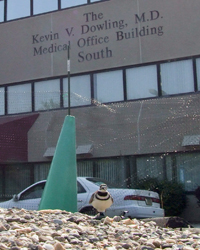
Killdeer lays her eggs in the middle of the Dowling South parking lot.
Some other killdeer info from birdwatching.com:
- Baby killdeer always come out running. They hatch with their eyes open, and as soon as their downy feathers dry, they start scurrying about, following their parents and searching the ground for something to eat.
- Newly-hatched killdeer can't fly, and they need their killdeer parents for protection and guidance, but they are a lot closer to independence than most baby birds.
- The parent killdeer start sitting on the eggs to incubate them as soon as all the eggs have been laid. The killdeer embryos inside the first-laid three eggs do not start developing while the eggs are sitting out in the cold. But when they feel the warmth of the parent killdeer, all four killdeer embryos start developing at the same time.
- So even though the first-laid egg spends a longer time in the shell than the last-laid, all the killdeer chicks have the same development period. It takes 24 to 28 days of incubating for the chicks to hatch.
- Although killdeer are technically in the family of shorebirds, they are unusual shorebirds in that they often nest and live far from water. They like to nest in gravel, and they will take it where they find it.
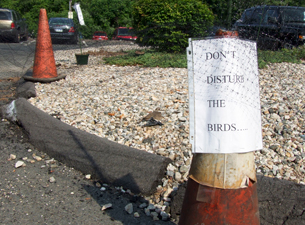
Killdeer nesting area is cordoned off by cones.
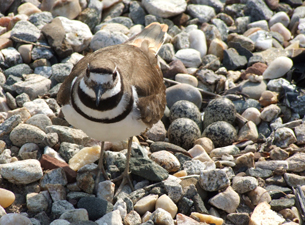
Killdeer guards her eggs. Can you spot them?
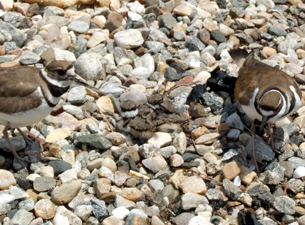
The proud parents protecting their babies.
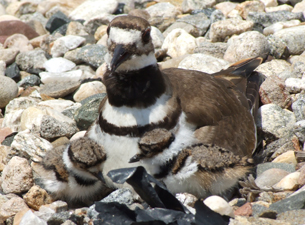
Killdeer with two of her chicks. The other two are nestled beneath her.


